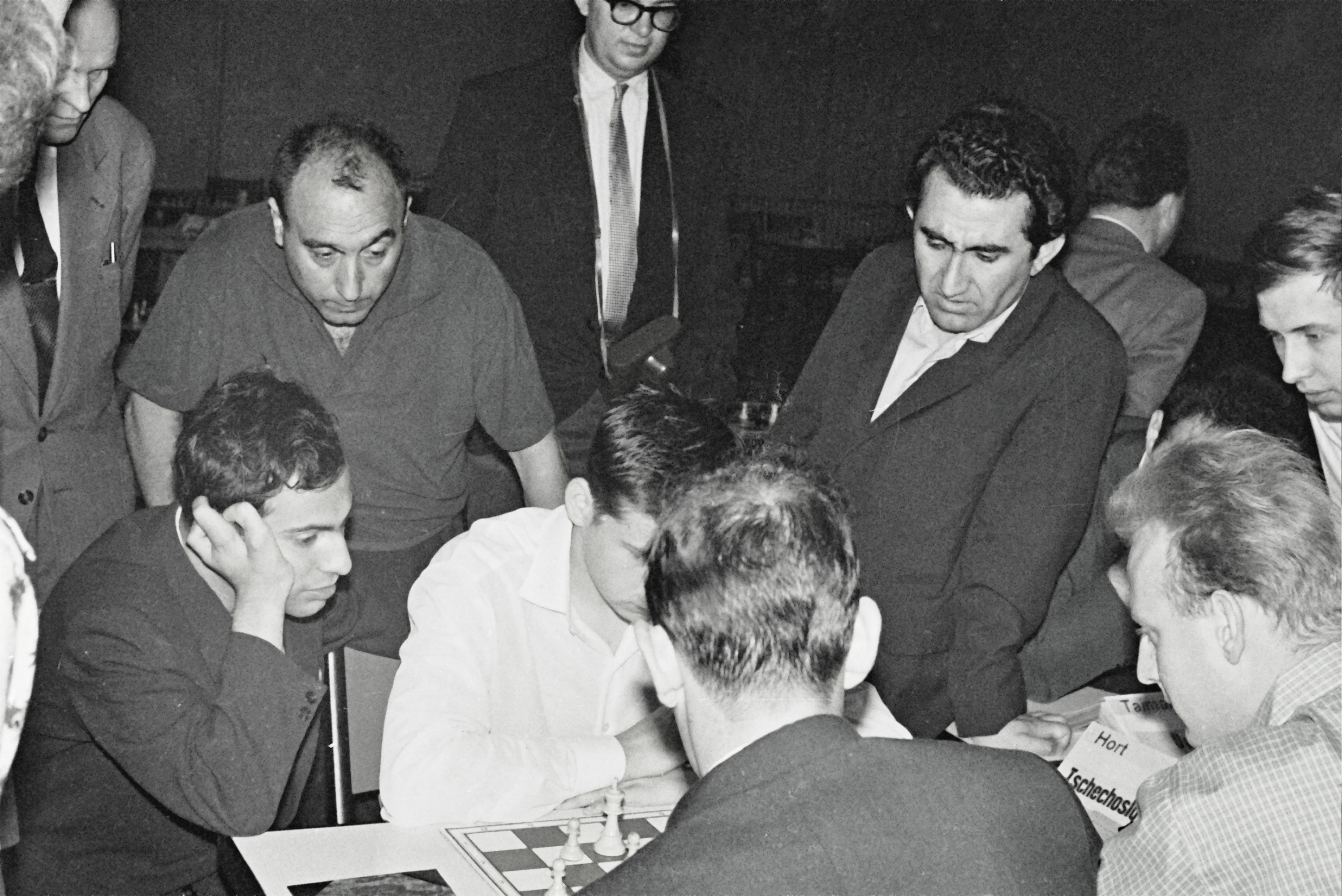|
Minority Attack
In chess, a minority attack is the advancement of one's pawns on the side of the board where one has fewer pawns than their opponent, intending to use their minority to strategically provoke a weakness (i.e, an isolated or backward pawn) in the opponent's pawn structure. The minority attack is a common middlegame plan that can be played in many pawn structures. The name might be misleading, as the "attack" does not involve tactics planned to produce checkmate or significant material gain, but rather a strategical and structural advantage for the attacking player. The minority attack can be strengthened by the moving of one or both rooks to the files where the attacking player intends to advance their pawns, planning prophylactically for the opening of the files. Common openings that result in pawn structures where a minority attack is effective include the Queen's Gambit Declined and the Caro-Kann Defense. The minority attack occurs most commonly on the queenside, as players ... [...More Info...] [...Related Items...] OR: [Wikipedia] [Google] [Baidu] |
Pawn Structure
In a game of chess, the pawn structure (sometimes known as the pawn skeleton) is the configuration of pawn (chess), pawns on the chessboard. Because pawns are the least mobile of the chess pieces, the pawn structure is relatively static and thus plays a large role in determining the strategic character of the position. General observations Weaknesses in the pawn structure, such as Isolated pawn, isolated, Doubled pawns, doubled, or Backward pawn, backward pawns and , once created, are usually permanent. Care must therefore be taken to avoid them (but there are exceptions—for instance see ''Boleslavsky hole'' below). In the absence of these structural weaknesses, it is not possible to assess a pawn formation as good or bad—much depends on the position of the pieces. The pawn formation does determine the overall strategies of the players to a large extent, however, even if arising from unrelated openings. Pawn formations symmetrical about a vertical line (such as the #e5-chain, ... [...More Info...] [...Related Items...] OR: [Wikipedia] [Google] [Baidu] |
Prophylaxis (chess)
In chess, prophylaxis consists of a move or series of moves done by a player to prevent their opponent from taking some action. Such preventive moves, or ''prophylactic moves'', aim not only to improve one's position but also to restrict the opponent in improving their own. Many standard and widespread opening moves can be considered prophylactic. One common prophylactic idea is the advance of the near a castled king, which can be done to provide luft and/or to prevent a pin; another is to transfer one's king to the b-file after castling queenside so as to protect an unmoved a-pawn, among other purposes. Prophylaxis is a distinctive feature of , often preventing opponents from entering risky, double-edged lines, as well as punishing opponents who play too aggressively. Using prophylaxis is an essential skill at advanced levels of play. Famous practitioners of prophylactic play include Aron Nimzowitsch, Tigran Petrosian, and Anatoly Karpov; even players, such as Mikhail Tal ... [...More Info...] [...Related Items...] OR: [Wikipedia] [Google] [Baidu] |
Mikhail Tal
Mikhail Tal (9 November 1936 – 28 June 1992) was a Soviet and Latvian chess player and the eighth World Chess Champion. He is considered a creative genius and is widely regarded as Comparison of top chess players throughout history, one of the most influential players in chess history. Tal played in an attacking and daring combinatorial style. His play was known above all for improvisation and unpredictability. Vladislav Zubok said of him, "Every game for him was as inimitable and invaluable as a poem". His nickname was "Misha (name), Misha", a diminutive for Michael (given name), Mikhail, and he earned the nickname "The Magician from Riga". Both ''The Mammoth Book of the World's Greatest Chess Games'' and ''Modern Chess Brilliancies'' include more games by Tal than any other player. He also held the record for the longest unbeaten streak in competitive chess history with 95 games (46 wins, 49 draws) between 23 October 1973 and 16 October 1974, until Ding Liren's streak o ... [...More Info...] [...Related Items...] OR: [Wikipedia] [Google] [Baidu] |
Yasser Seirawan
Yasser Seirawan (; born March 24, 1960) is a Syrian-born American chess grandmaster and four-time United States Chess Championship, United States champion. He won the World Junior Chess Championship in 1979. Seirawan is also a published chess author and commentator. Early life Seirawan was born in Damascus, Syria. His father was Syrian and his mother an English nurse from Nottingham, where he spent some time in his early childhood. When he was seven, his family immigrated to Seattle, Washington, where he attended Queen Anne Elementary School, Edmond S. Meany Middle School, Meany Middle School, and Garfield High School (Seattle, Washington), Garfield High School. He honed his game at a now-defunct coffeehouse, the Last Exit on Brooklyn, playing against the likes of Latvian-born master Viktors Pupols and six-time Washington (state), Washington State Champion James Harley McCormick. Career Seirawan began playing chess at 12; at 13, he became Washington junior champion. At 19, he ... [...More Info...] [...Related Items...] OR: [Wikipedia] [Google] [Baidu] |
Tigran Petrosian
Tigran Vardani Petrosian (; ; 17 June 1929 – 13 August 1984) was a Soviet-Armenian chess grandmaster and the ninth World Chess Champion from 1963 to 1969. He was nicknamed "Iron Tigran" due to his almost-impenetrable defensive playing style, which emphasized safety above all else. Petrosian is often credited with popularizing chess in Armenia. Petrosian was a candidate for the World Chess Championship on eight occasions (World Chess Championship 1954#1953 Candidates tournament, 1953, World Chess Championship 1957#1956 Candidates tournament, 1956, World Chess Championship 1960#1959 Candidates tournament, 1959, World Chess Championship 1963#Candidates Tournament, 1962, World Chess Championship 1972#1971 Candidates matches, 1971, World Chess Championship 1975#1974 Candidates tournament, 1974, World Chess Championship 1978#1977 Candidates tournament, 1977 and World Chess Championship 1981#1980/81 Candidates Tournament, 1980). He won the World Chess Championship 1963, World C ... [...More Info...] [...Related Items...] OR: [Wikipedia] [Google] [Baidu] |
Joël Lautier
Joël Lautier () is a French chess grandmaster and one of the world's leading chess players in the 1990s and early 2000s. In 1986, he won the U-14 World Youth Chess Championship in Puerto Rico, Argentina. In 1988, he won the World Junior Chess Championship, ahead of stars such as Vasily Ivanchuk, Boris Gelfand and Gregory Serper. He is the youngest player ever to win the World Junior Championship at the age of 15. He is one of the few players who has a lifetime positive score against Garry Kasparov. He was one of the people instrumental in Kramnik winning the 2000 World Championship against Kasparov by preparing the infamous 'Berlin Wall'. He also won the French Chess Championship twice in 2004 and 2005. He was the first president of the Association of Chess Professionals when it was founded in June 2003. In 2006, Lautier gave up competitive chess to pursue a career in investment banking. Since 2009 he has been CEO of the Moscow-based investment banking firm RGG Capital. ... [...More Info...] [...Related Items...] OR: [Wikipedia] [Google] [Baidu] |
Chess Annotation Symbols
When annotating chess games, commentators frequently use widely recognized annotation symbols. Question marks and exclamation points that denote a move as bad or good are ubiquitous in chess literature. Some publications intended for an international audience, such as the ''Chess Informant'', have a wide range of additional symbols that transcend language barriers. The common symbols for evaluating the merits of a move are "??", "?", "?!", "!?", "!", and "!!". The chosen symbol is appended to the text describing the move (e.g. Re7? or Kh1!?); see Algebraic chess notation. Use of these annotation symbols is subjective, as different annotators use the same symbols differently or for a different reason. Evaluation symbols Moves Move evaluation symbols, by decreasing severity or increasing effectiveness of the move: ?? (Blunder) The double question mark "??" indicates a blunder, a critically bad mistake. Typical moves that receive double question marks are those tha ... [...More Info...] [...Related Items...] OR: [Wikipedia] [Google] [Baidu] |
Anatoly Karpov
Anatoly Yevgenyevich Karpov (, ; born May 23, 1951) is a Russian and former Soviet Grandmaster (chess), chess grandmaster, former World Chess Championship, World Chess Champion, and politician. He was the 12th World Chess Champion from 1975 to 1985, a three-time FIDE World Champion (1993, 1996, 1998), twice World Chess champion as a member of the USSR team (1985, 1989), and a six-time winner of Chess Olympiad, Chess Olympiads as a member of the USSR team (1972, 1974, 1980, 1982, 1986, 1988). The International Association of Chess Press awarded him nine Chess Oscars (1973–77, 1979, 1980, 1981, 1984). Karpov's chess tournament successes include over 160 first-place finishes. He had a peak Elo rating system, Elo rating of 2780, and his 102 total months world number one is the third-longest of all time, behind Magnus Carlsen and Garry Kasparov. Karpov is also an elected Member of the State Duma in Russia. Since 2006, he has chaired the Commission for Ecological Safety and Envir ... [...More Info...] [...Related Items...] OR: [Wikipedia] [Google] [Baidu] |
Castling
Castling is a move in chess. It consists of moving the king (chess), king two squares toward a rook (chess), rook on the same and then moving the rook to the square that the king passed over. Castling is permitted only if neither the king nor the rook has previously moved; the squares between the king and the rook are vacant; and the king does not leave, cross over, or finish on a square attacked by an enemy piece. Castling is the only move in chess in which two pieces are moved at once. Castling with the is called ''kingside castling'', and castling with the is called ''queenside castling''. In both Algebraic notation (chess), algebraic and descriptive notation, descriptive notations, castling kingside is written as 0-0 and castling queenside as 0-0-0. Castling originates from the ''king's leap'', a two-square king move added to European chess between the 14th and 15th centuries, and took on its present form in the 17th century. Local variations in castling rules were ... [...More Info...] [...Related Items...] OR: [Wikipedia] [Google] [Baidu] |
Queenside
This glossary of chess explains commonly used terms in chess, in alphabetical order. Some of these terms have their own pages, like ''fork'' and ''pin''. For a list of unorthodox chess pieces, see Fairy chess piece; for a list of terms specific to chess problems, see Glossary of chess problems; for a list of named opening lines, see List of chess openings; for a list of chess-related games, see List of chess variants; for a list of terms general to board games, see Glossary of board games. A B C D ... [...More Info...] [...Related Items...] OR: [Wikipedia] [Google] [Baidu] |
Queen's Gambit Declined
The Queen's Gambit Declined (or QGD) is a chess opening in which Black declines a pawn offered by White in the Queen's Gambit: :1. d4 d5 :2. c4 e6 This is known as the ''Orthodox Line'' of the Queen's Gambit Declined. When the "Queen's Gambit Declined" is mentioned, it is usually assumed to be referring to the Orthodox Line; see " Other lines" below. The Orthodox Line can be reached by a number of different , such as 1.d4 Nf6 2.c4 e6 3.Nf3 d5; 1.d4 e6 2.c4 d5; 1.c4 e6 2.Nc3 d5 3.d4; 1.Nf3 d5 2.c4 e6 3.d4; and so on. General concepts Playing 2...e6 releases Black's , while obstructing Black's . By declining White's temporary pawn sacrifice, Black erects a solid position; the pawns on d5 and e6 give Black a foothold in the . The Queen's Gambit Declined has the reputation of being one of Black's most reliable defenses to 1.d4. In this situation, White will try to exploit the passivity of Black's light-squared bishop, and Black will try to release it, trade it, or prove that, ... [...More Info...] [...Related Items...] OR: [Wikipedia] [Google] [Baidu] |


